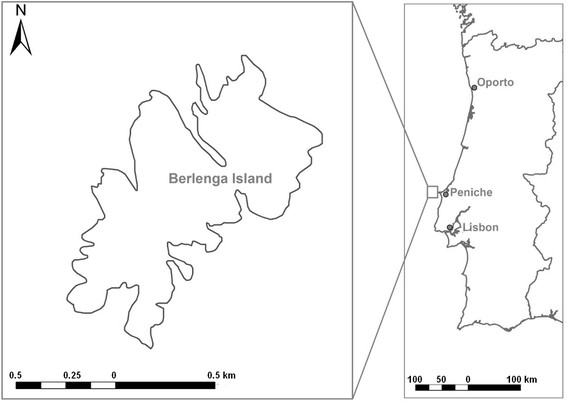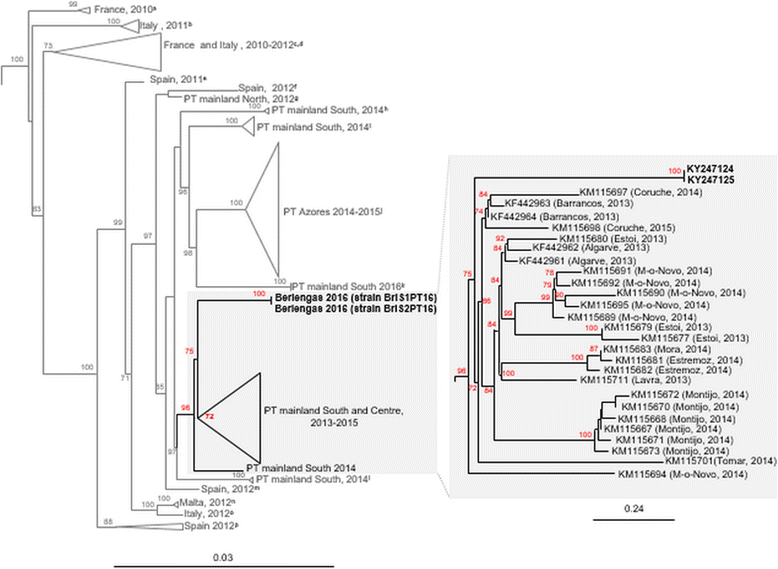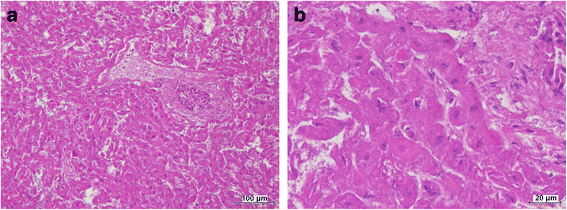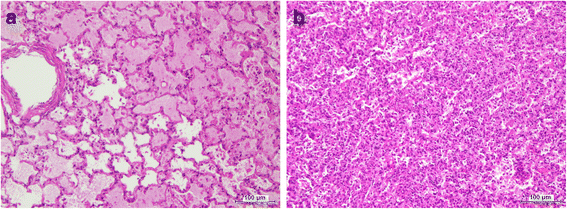Detection of rabbit Haemorrhagic disease virus 2 during the wild rabbit (Oryctolagus cuniculus) eradication from the Berlengas archipelago, Portugal
- PMID: 29141631
- PMCID: PMC5688637
- DOI: 10.1186/s12917-017-1257-3
Detection of rabbit Haemorrhagic disease virus 2 during the wild rabbit (Oryctolagus cuniculus) eradication from the Berlengas archipelago, Portugal
Abstract
Background: In the regular wildlife monitoring action carried out in the summer of the past few years at the Berlenga Island, wild rabbits (Oryctolagus cuniculus) have been repeatedly found dead. However, the origin of those deaths was never investigated. Our aim was to investigate the cause of death of 11 rabbits collected between April and May 2016.
Results: While screening samples from rabbit carcasses for the major viral rabbit pathogens, five tested positive to RHDV2 but all were negative for RHDV and myxoma virus (MYXV). For six RHDV2-negative specimens, emaciation and parasitism were considered the most probable cause of death. Lesions identified in the RHDV2-positive rabbits included non-suppurative diffuse hepatic necrosis and pulmonary lesions varying from congestion and oedema of the lungs to interstitial pneumonia. Sequencing analysis of the vp60 gene obtained from two specimens showed identical vp60 sequences. Comparison with other known RHDV2 strains from public databases through BLAST analysis revealed a closer similarity with strains from Alentejo collected during 2013. Maximum Likelihood and Bayesian phylogenetic analysis showed that the 2016 strains from the archipelago have a higher resemblance with a group of strains mostly collected in the South of Portugal between 2013 and 2014.
Conclusion: The results suggest that RHDV2 may have been introduced on the Berlenga Island a few years ago, having evolved separately from mainland strains due to insularity.
Keywords: Berlenga Island; Berlengas; Oryctolagus cuniculus; RHDV2; Rabbit haemorrhagic disease virus; UNESCO; Wild rabbit.
Conflict of interest statement
Ethics approval and consent to participate
This article does not contain any studies with human or animal subjects. All biological samples were collected from animals found dead in the Berlenga Island, Portugal. The carcasses were collected within the scope of the LIFE Berlengas project (Conserving threatened habitats and species in Berlengas SPA through sustainable management, LIFE13 NAT/PT/000458).
Consent for publication
Not applicable.
Competing interests
The authors declare that they have no competing interests. All permissions to handling animals and collect rabbit samples were obtained from the national authorities.
Publisher’s Note
Springer Nature remains neutral with regard to jurisdictional claims in published maps and institutional affiliations.
Figures





References
-
- Almeida T, Lopes AM, Magalhães MJ, Neves F, Pinheiro A, Gonçalves D, Leitão M, Esteves PJ, Abrantes J. Tracking the evolution of the G1/RHDVb recombinant strains introduced from the Iberian peninsula to the Azores islands. Portugal Infect Genet Evol. 2015;34:307–313. doi: 10.1016/j.meegid.2015.07.010. - DOI - PubMed
-
- Amado, A.; Gafeira, C.; Teixeira, A.; Preto, A. Relatório do Plano de Ordenamento da Reserva Natural das Berlengas. (2007) Instituto de Conservação da Natureza e Florestas, (in Portuguese).
MeSH terms
LinkOut - more resources
Full Text Sources
Other Literature Sources
Research Materials
Miscellaneous

